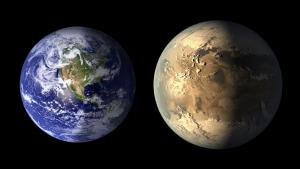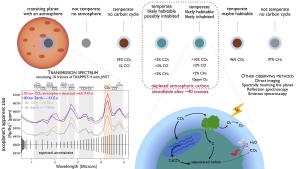Blog
The Odd Sibling
30 October 2023
 NASA’s Goddard Space Flight Center
NASA’s Goddard Space Flight CenterWith thousands of known exoplanets and tens of thousands likely to be discovered in the coming decades, it could be only a matter of time before we discover a planet with life. The trick is proving it. So far the focus has been on observing the atmospheric composition of exoplanets, looking for molecular biosignatures that would indicate the presence of life. But this can be difficult since many of the molecules produced by life on Earth could also be produced by geologic processes. A new study argues that a better approach would be to compare the atmospheric composition of a potentially habitable world with those of other planets in the star system.1
Since planets form within the debris disk of a young star, they will generally have similar compositions. Because of the migration of certain molecules such as water ice, the outer planets can have a slightly different composition than the inner planets, but overall their composition is similar. For this study, the team looked at the abundance of atmospheric carbon among worlds.
Carbon is not just a primary element for life on Earth, it also absorbs readily in water and can be bound geologically in rocks. So the idea is that if an exoplanet is in the potentially habitable zone of a star and has significantly less atmospheric carbon than similar worlds in its system, then that is a strong indicator of the presence of water and organic life. Take our solar system as an example. Earth, Venus, and Mars are all roughly in the habitable zone of the Sun, but both Venus and Mars have atmospheres comprised mostly of carbon dioxide. In contrast, Earth has an atmosphere of mostly nitrogen and oxygen, and only a fraction of a percent of carbon dioxide. Earth’s atmospheric carbon is so dramatically different from that of Venus and Mars that it stands out as a likely inhabited world.
 Triaud, et al
Triaud, et alAs a demonstration, the team looked at how this might work for the Trappist-1 star system. It’s a red dwarf star with seven known planets roughly the size of Earth. Three of these worlds fall within the potentially habitable zone, so it’s an excellent test case for comparing worlds. Based on the capabilities of the James Webb Space Telescope (JWST), it should be able to detect atmospheric carbon dioxide levels in the Trappist-1 planets. The authors estimate that ten or so clear transits of a Trappist world would be sufficient to determine whether it has a depleted CO2 level. If one of the potentially habitable worlds in the Trappist system has a depleted level, it would be a good candidate for further study.
The authors are careful to note that depleted CO2 levels by itself could be a false positive. While large oceans and the presence of life would reduce atmospheric carbon, there are other ways as well. Certain rocks can absorb tremendous amounts of carbon, for example. Also, since the Trappist planets could be tidally locked, the dark side of the planets could get cold enough to freeze CO2, thus removing it from the atmosphere. There are also ways that life could exist on a world without depleting atmospheric carbon, so if none of the Trappist worlds have low atmospheric carbon that still wouldn’t eliminate it from potentially having life.
This method wouldn’t be definitive, but it would reveal worlds worth studying in detail. Just as early exoplanet observations began by finding candidate planets that were later confirmed, JWST could find candidate living worlds, pointing the way to confirming extraterrestrial life. And that makes this approach pretty exciting.
Triaud, Amaury HMJ, et al. “Atmospheric carbon depletion as a tracer of water oceans and biomass on temperate terrestrial exoplanets.” arXiv preprint arXiv:2310.14987 (2023). ↩︎